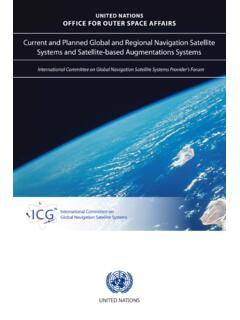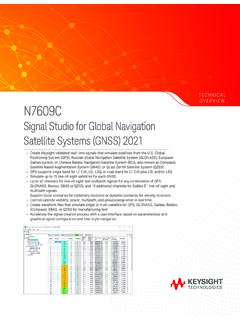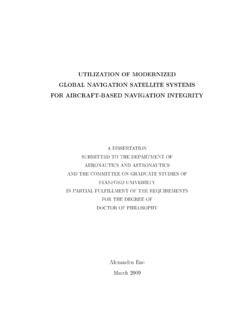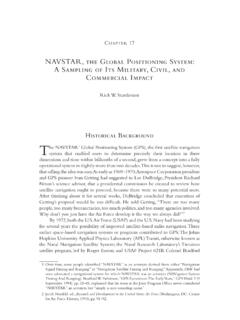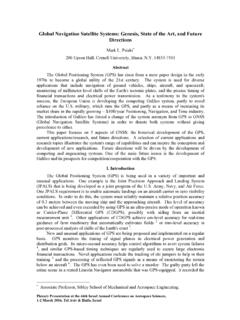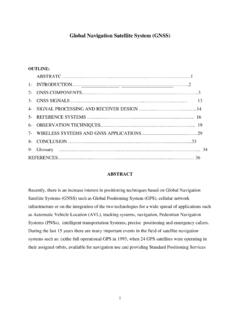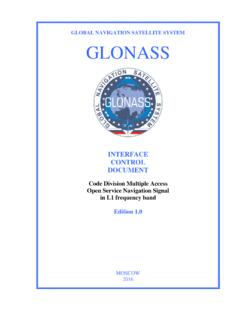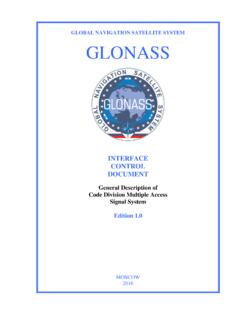Transcription of AIRWORTHINESS APPROVAL OF GLOBAL NAVIGATION …
1 AC-20-138A AIRWORTHINESS APPROVAL OF GLOBAL NAVIGATION satellite system ( gnss ) equipment December 22, 2003 12/22/03 AC 20-138A TABLE OF CONTENTS Paragraph Page 1. 2. 1 3. Related Federal Aviation 4. How to Use this 5. Definitions ..1 6. Related Reading 7. 8. APPROVAL 9. gnss equipment Limited to VFR 10. TSO 11. equipment Performance GPS 12. equipment Performance gnss 13. equipment Performance Stand Alone NAVIGATION 14.
2 equipment Performance LAAS VDB 15. Installation Issues 16. Installation Issues GPS 17. Installation Issues gnss 18. Installation Issues Stand Alone NAVIGATION 19. Installation Issues LPV and GLS 20. Installation Issues LAAS VDB 21. Data 22. Ground 23. Flight Test .. 38 APPENDIX 1: GPS Oceanic/Remote NAVIGATION (3 pages) APPENDIX 2: Integration of GLONASS with GPS or GPS/WAAS (4 pages) APPENDIX 3: Example Format for a Quick Reference Guide (8 pages) APPENDIX 4: Sample Airplane/Rotorcraft Flight Manual Supplement (5 pages) APPENDIX 5: Installation of En Route GPS equipment For VFR Use Only (2 pages)Page i (and ii) 12/22/03 AC 20-138A 1.
3 PURPOSE. This advisory circular (AC) provides guidance material for the AIRWORTHINESS APPROVAL of GLOBAL NAVIGATION satellite system ( gnss ) equipment . Like all AC material, this AC is not mandatory and does not constitute a regulation. It is issued for guidance purposes and to outline a method of compliance with the rules. In lieu of following this method without deviation, the applicant may elect to follow an alternate method, provided the alternate method is also found by the Federal Aviation Administration (FAA) to be an acceptable means of complying with the requirements of the federal aviation regulations (Title 14 of the Code of Federal Regulations, 14 CFR).
4 This AC addresses the following equipment : a. gnss sensors, including those incorporating Wide Area Augmentation system (WAAS), Local Area Augmentation system (LAAS), or the Russian GLOBAL NAVIGATION satellite system (GLONASS). b. gnss stand-alone NAVIGATION equipment that provides deviations (steering commands) for en route, terminal, or approach operations (including Category I precision approach). 2. CANCELLATION. a. AC 20-138, AIRWORTHINESS APPROVAL of GLOBAL Positioning system (GPS) NAVIGATION equipment for Use as a VFR and IFR Supplemental NAVIGATION system , dated May 25, 1994, is canceled. 3. RELATED FEDERAL AVIATION REGULATIONS. 14 CFR Parts 21, 23, 25, 27, 29, 43, 91, 121, and 135.
5 4. HOW TO USE THIS DOCUMENT. This document is organized into general categories of equipment and installations. Paragraph 8 summarizes the APPROVAL process and applies to all projects. Paragraph 9 applies to gnss as an aid to visual flight rules (VFR) NAVIGATION , while paragraphs 10 through 23 address instrument flight rules (IFR) NAVIGATION . Guidance concerning the equipment performance and functions is provided in paragraphs 11 through 14, and installation guidance is provided in paragraphs 15 through 20. Paragraphs 21 through 23 provide additional information on the data submittal, ground test and flight test as they apply to an installation APPROVAL . 5. DEFINITIONS. a. Aircraft-Based Augmentation system (ABAS).
6 An augmentation system that augments and/or integrates the information obtained from the other gnss elements with information available on board the aircraft. b. Ground-Based Augmentation system (GBAS). An augmentation system in which the user receives augmentation information directly from a ground-based transmitter. c. GLONASS. GLONASS is a Russian satellite based radio NAVIGATION system , which provides a positioning service anywhere in the world. Until the FAA declares GLONASS fully operational for aviation, its use is limited to a supplement to GPS NAVIGATION . The FAA will declare GLONASS fully operational after the system Par 1 Page 1 AC 20-138A 12/22/03 management and maintenance are mature.
7 The following capabilities are expected before the FAA will declare GLONASS operational for aviation: (1) Mature maintenance practices; (2) Commitment to maintain a complete constellation of satellites; and (3) Issuance of international NOTAMs prior to any scheduled maintenance, and after the onset of any unscheduled outages. d. GLOBAL NAVIGATION satellite system ( gnss ). The gnss is a generic term for satellite -based NAVIGATION , including GPS, SBAS, GBAS, GLONASS, and any other satellite NAVIGATION system . e. gnss Landing system (GLS). A satellite -based NAVIGATION system that provides precision approach (including SBAS/WAAS and GBAS/LAAS). f. GLOBAL Positioning system (GPS). GPS is a satellite based radio NAVIGATION system that provides a precise positioning service anywhere in the world.
8 The service provided by GPS for civil use is defined in the GPS Standard Positioning system Signal Specification. g. Local Area Augmentation system (LAAS). LAAS is the GBAS provided by the FAA. h. NAVIGATION . Within the context of this AC, NAVIGATION refers to any function used to direct the course of an aircraft. A NAVIGATION system as addressed in this AC provides the functions of position estimation, path definition, path steering, and situation indications and alerting to the flight crew. i. Receiver Autonomous Integrity Monitoring (RAIM). According to TSO-C129 (all revisions (AR)), any algorithm which verifies the integrity of the position output using GPS measurements, or GPS measurements and barometric aiding, is considered a RAIM algorithm.
9 An algorithm which uses additional information ( , multi-sensor system ) to verify the integrity of the position output may be acceptable as a RAIM-equivalent. Within this AC, the term RAIM is a synonym for ABAS and is used to refer to both RAIM or RAIM-equivalent algorithms. j. satellite -Based Augmentation system (SBAS). A wide coverage augmentation system in which the user receives augmentation information from a satellite -based transmitter. k. Special Category I (SCAT-I). In order to expedite the implementation of satellite -based NAVIGATION , the aeronautical industry and the FAA in 1993 developed RTCA/DO-217, Minimum Aviation system Performance Standards (MASPS) DGNSS Instrument Approach system : Special Category I.
10 The FAA adopted this standard in Order , IFR APPROVAL for Differential GLOBAL Positioning system Special Category I Instrument Approaches Using Private Ground Facilities. The intent of SCAT-I is the same as LAAS, except it is limited to Category I precision approach and does not ensure interoperability between different vendors. SCAT-I allows private facilities to be fielded before all of the issues associated with a public system are Page 2 Par 5 12/22/03 AC 20-138A resolved.










